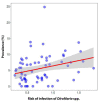Current Risk of Dirofilariosis Transmission in the Iberian Peninsula (Spain and Portugal) and the Balearic Islands (Spain) and Its Future Projection under Climate Change Scenarios
- PMID: 37465861
- PMCID: PMC10251949
- DOI: 10.3390/ani13111764
Current Risk of Dirofilariosis Transmission in the Iberian Peninsula (Spain and Portugal) and the Balearic Islands (Spain) and Its Future Projection under Climate Change Scenarios
Abstract
Dirofilariosis is a vector-borne zoonotic disease whose distribution is linked to the presence of culicid mosquitoes. Spain and Portugal are considered endemic countries; however, the distribution of dirofilariosis is not uniform. Our aim was to develop a more accurate risk model of dirofilariosis transmission for the Iberian Peninsula (Spain and Portugal) and the Balearic Islands (Spain). To do this, we used a set of key variables related to parasite transmission: the potential distribution of suitable habitats for Culex pipiens calculated via an ecological niche model (ENM) and the potential number of Dirofilaria spp. generations. The resulting model was validated with the prevalence and geolocation of D. immitis-infected dogs from all provinces and districts. In addition, the impact of possible future climatic conditions was estimated. A quantitative estimate of the risk of infection by Dirofilaria spp. was obtained at a resolution of 1 km2. The entire analyzed territory was susceptible to contact with the parasite. The highest risk of infection was found throughout the eastern coastal strip and the south of the Iberian Peninsula and the Balearic Islands, as well as in the areas surrounding the basins of the main rivers, and the lowest risk was located in the higher-altitude areas. We found a robust and positive relationship between the risk of dirofilariosis and the observed prevalence of infested dogs in the study area (β ± SE = 3.32 ± 1.43 p < 0.05). In 2080, the percentage of territory gain for Cx. pipiens will increase to 49.98%, which will increase the risk of infection. This new model provides a high predictive value for the current and predicted presence and risk and can serve as a tool for the management and control of dirofilariosis.
Keywords: Culex pipiens; Dirofilaria spp.; Iberian Peninsula; Portugal; Spain; ecological niche model; forward projection.
Conflict of interest statement
The authors declare no conflict of interest.
Figures







Similar articles
-
Prediction and validation of potential transmission risk of Dirofilaria spp. infection in Serbia and its projection to 2080.Front Vet Sci. 2024 Apr 3;11:1352236. doi: 10.3389/fvets.2024.1352236. eCollection 2024. Front Vet Sci. 2024. PMID: 38634104 Free PMC article.
-
Assessment Heartworm Disease in the Canary Islands (Spain): Risk of Transmission in a Hyperendemic Area by Ecological Niche Modeling and Its Future Projection.Animals (Basel). 2023 Oct 18;13(20):3251. doi: 10.3390/ani13203251. Animals (Basel). 2023. PMID: 37893976 Free PMC article.
-
Ecological niche modeling analysis (Cx. pipiens), potential risk and projection of Dirofilaria spp. infection in Greece.Vet Parasitol. 2024 Jun;328:110172. doi: 10.1016/j.vetpar.2024.110172. Epub 2024 Mar 19. Vet Parasitol. 2024. PMID: 38547829
-
Dirofilariosis in the Americas: a more virulent Dirofilaria immitis?Parasit Vectors. 2013 Oct 2;6(1):288. doi: 10.1186/1756-3305-6-288. Parasit Vectors. 2013. PMID: 24274042 Free PMC article. Review.
-
Subcutaneous dirofilariosis (Dirofilaria repens): an infection spreading throughout the old world.Parasit Vectors. 2017 Nov 9;10(Suppl 2):517. doi: 10.1186/s13071-017-2434-8. Parasit Vectors. 2017. PMID: 29143643 Free PMC article. Review.
Cited by
-
Prediction and validation of potential transmission risk of Dirofilaria spp. infection in Serbia and its projection to 2080.Front Vet Sci. 2024 Apr 3;11:1352236. doi: 10.3389/fvets.2024.1352236. eCollection 2024. Front Vet Sci. 2024. PMID: 38634104 Free PMC article.
-
Raising Awareness of Canine, Feline and Human Dirofilariosis in Aveiro, Portugal: A One Health Perspective.Animals (Basel). 2025 Mar 26;15(7):952. doi: 10.3390/ani15070952. Animals (Basel). 2025. PMID: 40218346 Free PMC article.
-
Assessment Heartworm Disease in the Canary Islands (Spain): Risk of Transmission in a Hyperendemic Area by Ecological Niche Modeling and Its Future Projection.Animals (Basel). 2023 Oct 18;13(20):3251. doi: 10.3390/ani13203251. Animals (Basel). 2023. PMID: 37893976 Free PMC article.
-
Canine vector-borne parasites in the Galapagos.Parasit Vectors. 2024 Dec 18;17(1):515. doi: 10.1186/s13071-024-06592-z. Parasit Vectors. 2024. PMID: 39696600 Free PMC article.
-
Current State of Canine Heartworm in Portugal.Animals (Basel). 2024 Apr 25;14(9):1300. doi: 10.3390/ani14091300. Animals (Basel). 2024. PMID: 38731304 Free PMC article.
References
-
- Fick S.E., Hijmans R.J. WorldClim 2: New 1-km spatial resolution climate surfaces for global land areas. Intern. J. Climatol. 2017;37:4302–4315. doi: 10.1002/joc.5086. - DOI
-
- Gangoso L., Aragonés D., Martínez-de la Puente J., Lucientes J., Delacour-Estrella S., Estrada Peña R., Montalvo T., Bueno-Marí R., Bravo-Barriga D., Frontera E., et al. Determinants of the current and future distribution of the West Nile virus mosquito vector Culex pipiens in Spain. Env. Res. 2020;188:109837. doi: 10.1016/j.envres.2020.109837. - DOI - PubMed
LinkOut - more resources
Full Text Sources
Miscellaneous

